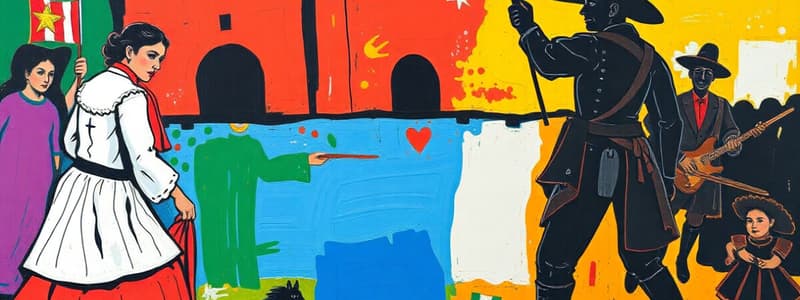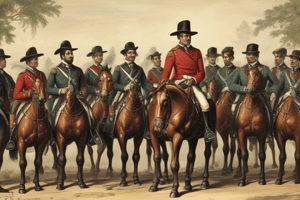Podcast
Questions and Answers
What was the primary reason for President Polk's order to send Winfield Scott's forces inland from Vera Cruz?
What was the primary reason for President Polk's order to send Winfield Scott's forces inland from Vera Cruz?
- To provide humanitarian aid to Mexican citizens suffering from a cholera outbreak.
- To secure California before other nations could claim it.
- To establish a naval blockade and cut off Mexican trade routes.
- To pressure the Mexican government into negotiating after previous attempts had failed. (correct)
Which of the following best describes the significance of the Treaty of Guadalupe Hidalgo?
Which of the following best describes the significance of the Treaty of Guadalupe Hidalgo?
- It formally recognized Texas as an independent republic, resolving border disputes.
- It initiated a program of economic aid from the United States to help Mexico rebuild after the war.
- It established a joint U.S.-Mexican commission to oversee immigration policies.
- It marked the end of the Mexican-American War and confirmed the annexation of Texas and cession of vast territories to the U.S. (correct)
What territories did the United States gain as a result of the Treaty of Guadalupe Hidalgo?
What territories did the United States gain as a result of the Treaty of Guadalupe Hidalgo?
- Florida, Louisiana, and Arkansas
- Texas, Oregon, and Washington
- Arizona, Nevada, and Colorado
- California, New Mexico, and Texas (correct)
Which event directly preceded the Treaty of Guadalupe Hidalgo?
Which event directly preceded the Treaty of Guadalupe Hidalgo?
What action by the Mexican government triggered Polk to order troops to march inland from Vera Cruz?
What action by the Mexican government triggered Polk to order troops to march inland from Vera Cruz?
Which factor most directly spurred American interest in the annexation of California during the 1840s?
Which factor most directly spurred American interest in the annexation of California during the 1840s?
How did the issue of slavery contribute to the Texas Revolt?
How did the issue of slavery contribute to the Texas Revolt?
How did the Mexican government's policies in the 1820s and 1830s regarding American settlement in Texas contribute to the Texas Revolt?
How did the Mexican government's policies in the 1820s and 1830s regarding American settlement in Texas contribute to the Texas Revolt?
Which of the following best describes the objectives of Stephen Austin and the American settlers in Texas leading up to the Texas Revolt?
Which of the following best describes the objectives of Stephen Austin and the American settlers in Texas leading up to the Texas Revolt?
What symbolic element in John Gast's 1872 painting most directly represents the concept of 'Manifest Destiny'?
What symbolic element in John Gast's 1872 painting most directly represents the concept of 'Manifest Destiny'?
What was the significance of Richard Henry Dana's Two Years Before the Mast in relation to westward expansion?
What was the significance of Richard Henry Dana's Two Years Before the Mast in relation to westward expansion?
John Gast's painting presents a particular view of westward expansion. Which important aspect of the depicted relationship is notably absent?
John Gast's painting presents a particular view of westward expansion. Which important aspect of the depicted relationship is notably absent?
How did economic factors influence the relationships between American settlers and the Tejano population in Texas?
How did economic factors influence the relationships between American settlers and the Tejano population in Texas?
How did the opening of the Santa Fe Trail in 1821 primarily impact New Mexico?
How did the opening of the Santa Fe Trail in 1821 primarily impact New Mexico?
What was the result of the Mexican government annulling existing land contracts and barring future emigration from the United States?
What was the result of the Mexican government annulling existing land contracts and barring future emigration from the United States?
How did the Mexican government's 1834 decision to dissolve mission landholdings in California affect the existing social structure?
How did the Mexican government's 1834 decision to dissolve mission landholdings in California affect the existing social structure?
What was the primary motivation for Moses Austin's initial request for a land grant in Texas from the Mexican government?
What was the primary motivation for Moses Austin's initial request for a land grant in Texas from the Mexican government?
In the context of westward expansion, what distinguished the settlement of Oregon from the acquisition of Mexican territories?
In the context of westward expansion, what distinguished the settlement of Oregon from the acquisition of Mexican territories?
What was a primary motivation behind Mexico's decision to dissolve the mission landholdings in California in 1834?
What was a primary motivation behind Mexico's decision to dissolve the mission landholdings in California in 1834?
How did the Californios primarily define their cultural identity in relation to the surrounding population?
How did the Californios primarily define their cultural identity in relation to the surrounding population?
What key factor contributed to the shift in New Mexico's economic orientation towards the United States in the early 19th century?
What key factor contributed to the shift in New Mexico's economic orientation towards the United States in the early 19th century?
Flashcards
Treaty of Guadalupe Hidalgo
Treaty of Guadalupe Hidalgo
Treaty signed in February 1848 ending the Mexican-American War, confirming U.S. annexation of Texas, and ceding California and New Mexico.
Winfield Scott
Winfield Scott
U.S. Army General who led American forces to capture Mexico City in the Mexican-American War.
Annexation of Texas
Annexation of Texas
The incorporation of Texas into the United States, which was a major point of conflict leading to the Mexican-American War.
Mexican-American War
Mexican-American War
Signup and view all the flashcards
California Cession
California Cession
Signup and view all the flashcards
Richard Henry Dana
Richard Henry Dana
Signup and view all the flashcards
Mormon Migration
Mormon Migration
Signup and view all the flashcards
Annexation of California
Annexation of California
Signup and view all the flashcards
Tejanos
Tejanos
Signup and view all the flashcards
Moses Austin
Moses Austin
Signup and view all the flashcards
Stephen Austin
Stephen Austin
Signup and view all the flashcards
Slavery in Texas
Slavery in Texas
Signup and view all the flashcards
Economic Alliances
Economic Alliances
Signup and view all the flashcards
Manifest Destiny
Manifest Destiny
Signup and view all the flashcards
John Gast's Painting
John Gast's Painting
Signup and view all the flashcards
Mexican Independence
Mexican Independence
Signup and view all the flashcards
Santa Fe Trail
Santa Fe Trail
Signup and view all the flashcards
Californios
Californios
Signup and view all the flashcards
Populations in New Mexico (1821)
Populations in New Mexico (1821)
Signup and view all the flashcards
California's Demographics (1821)
California's Demographics (1821)
Signup and view all the flashcards
Dissolution of Missions
Dissolution of Missions
Signup and view all the flashcards
Study Notes
Chapter 13 Overview
- This chapter covers key events and figures from approximately 1820 to 1861, leading up to the American Civil War.
- Events include Manifest Destiny, expansion, westward migration, the Mexican-American War, and the rise of sectional tensions over slavery.
Key Events and Figures
- 1820s-1840s: Moses Austin received a Mexican land grant.
- 1836: Texas declared independence from Mexico.
- 1845: James K. Polk was inaugurated as president.
- 1846-1848: The Mexican-American War.
- 1846: Henry David Thoreau jailed for protesting the war.
- 1848: Treaty of Guadalupe Hidalgo, Gold Rush
- 1850s: Compromise of 1850, Fugitive Slave Act, Kansas-Nebraska Act.
- 1850s: Rise of the Know-Nothing Party, Republican Party organized.
- 1856: Bleeding Kansas
- 1857: Franklin Pierce was inaugurated.
- 1857: Dred Scott decision.
- 1858: Lincoln-Douglas debates.
- 1859: John Brown's raid on Harpers Ferry.
- 1860: South Carolina seceded from the Union.
- 1861: Abraham Lincoln was inaugurated; Fort Sumter was fired upon.
Key Concepts
- Manifest Destiny: Belief that the United States was destined to expand across the North American continent.
- Texas Revolt: Texas settlers revolted against Mexican rule, ultimately gaining independence and seeking annexation by the United States.
- Mexican-American War: Conflict between the United States and Mexico over territory.
- Compromise of 1850: Series of legislative measures aimed at resolving the issue of slavery in newly acquired territories.
- Fugitive Slave Act: Part of the Compromise of 1850, this act made it a federal crime to assist runaway slaves.
- Kansas-Nebraska Act: Act that allowed for popular sovereignty in Kansas and Nebraska regarding the issue of slavery.
- Dred Scott Decision: Supreme Court ruling that concluded African Americans were not citizens and could not sue in federal court.
- Lincoln-Douglas Debates: Series of debates between Lincoln and Douglas during the 1858 Illinois Senate race.
- John Brown's Raid: Abolitionist John Brown's attempt to initiate a slave uprising in Virginia.
- Secession: Withdrawal of eleven southern states from the Union in 1860-1861, preceding the Civil War.
- The Republican Party: Political party formed in opposition to the expansion of slavery, uniting various factions opposing the extension of slavery into new territories.
Studying That Suits You
Use AI to generate personalized quizzes and flashcards to suit your learning preferences.




